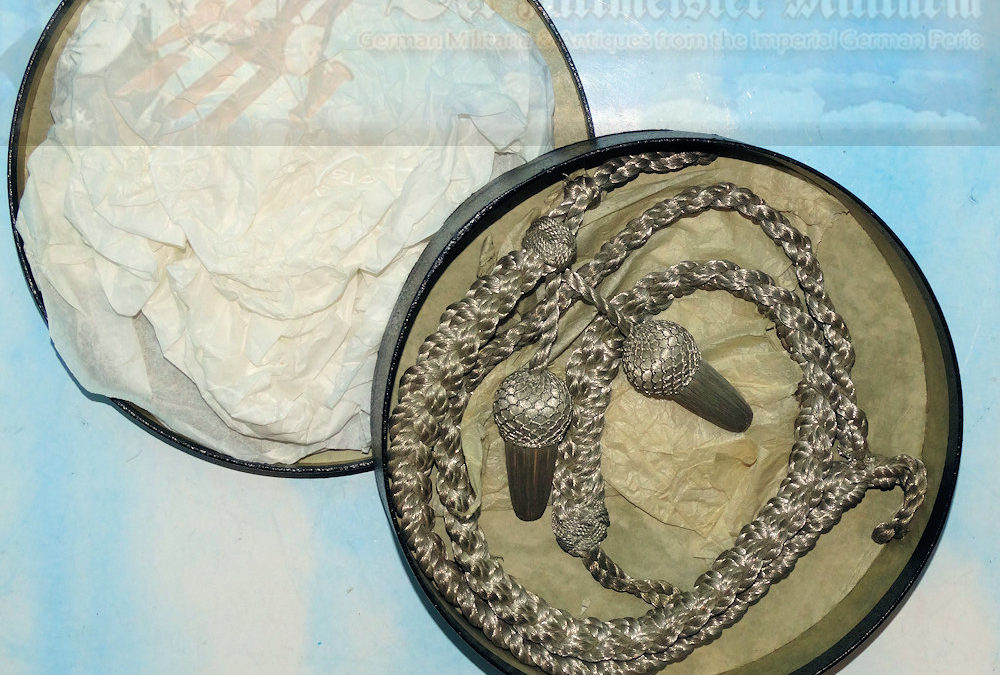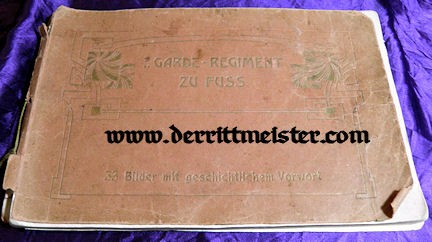
PRUSSIA – SHOOTING AWARD – OFFICER – 1. GARDE-REGIMENT ZU FUß – ORIGINAL PRESENTATION BOX
PRUSSIA – SHOOTING AWARD – OFFICER – 1. GARDE-REGIMENT ZU FUß – ORIGINAL PRESENTATION BOX
Extremely special shooting award for the regimental commander of the 1. Garde-Regiment zu Fuß. This regiment was the most elite of all German infantry regiments. 1. Garde Regiment zu Fuß had more noblemen and members of royalty who served in the regiment or were a la Suite officers than ANY other regiment.
Founded in 1688, making it amongst the oldest Prussian infantry regiments, 1. Garde-Regiment zu Fuß, had a long and proud history. The regiment was garrisoned in Potsdam where the most prestigious of the Garde-Regiments were based. This included the Regiment des Garde du Corps. Pretty rich company!
This shooting award, first authorized in January 190, was worn until 1914. Below is a list of the regimental commanders of 1. Garde-Regiment zu Fuß. It should be noted that each man went on to become a general officer before he retired:
• Karl von Plattenberg
• Gustav von Berg
• Karl Wilhelm von Willisen
• Friedrich von Kleist
• Friedrich von Friedeburg
• Prinz Eitel Friedrich (The second son of Kaiser Wilhelm II.)
• Friedrich von Bismarck
This list consists of seven men who served as regimental commander from1901-1914. This is a very elite group and as we continue our description you will find out how very special this item is. We cannot say with certainty which of the seven this shooting award belonged to, it does narrow down the owner.
The shooting award or shooting badge or more formally “Schützenschnur” (Besondere Kaiser Schnur as it was bestowed by the Kaiser).
The badge consists of a massive rope of silver bullion that extends 49”. At the bottom are two large silver bullion and silk formed acorn shapes. At the top is a loop where it would be attached to the tunic in a similar fashion to an aiguillette.
This lovely Schützenschnur comes wrapped in the original tissue paper and is housed in a circular black leatherette storage carton which measures 8” in diameter.
Further information on this impressive item can be found in “Uniformengeschicte des Prussichen Heers 1808-1914 Volume 1 Page 253.”
This item is in MINT condition. Remember that it was awarded from the hands of Kaiser Wilhelm II to one of the seven men above.
This would display well on its own or on a tunic from 1. Garde-Regiment zu Fuß.
http://www.derrittmeister.com/product/prussia-pickelhaube-officers-parade-1-garde-regiment-zu-fus-service-spike-semper-talis-bandeau/?v=7516fd43adaa
http://www.derrittmeister.com/product/album-thirty-three-photographs-diagrams-1-garde-regiment-zu-fus-prussia/?v=7516fd43adaa

